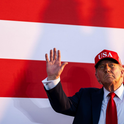About two years ago I was asked by Prospect to write a piece on whether globalisation was over. My conclusion then was that the answer was no. Globalisation had simply gone too far, I argued; it’s too deeply embedded; producers rely too heavily on trade and global supply chains to kill the golden goose.
To be sure, I acknowledged that the era of hyper-globalisation—where the volume of cross-border transactions grew significantly faster than the production of goods and services—was probably over. Improvements in communications technologies facilitating the unpacking of production and just-in-time production and inventory practices had reached the point of diminishing returns. The containerisation revolution could only occur once. China’s rise to pre-eminence was likewise a one-time event. A regulatory crackdown was likely to squeeze cross-border bank-intermediated capital flows, but bond- and equity-related borrowing and lending, which showed no signs of declining after the global financial crisis, would remain buoyant.
Overall, I insisted, there was no reason to think that globalisation was over. Its advantages were manifest. Its value to producers and consumers was clear. Globalisation created strains. But it was too deeply entrenched to be reversed.
The summer of 2016, when I wrote this piece, was, of course, prior to the election of Donald Trump, and also before the full implications of the Brexit vote were clear; certainly, nobody knew at the time whether or not London would reject a customs union agreement with the European Union, as Theresa May would subsequently signal. Given these developments, do I need to reconsider my conclusions?
I view these questions from a historical perspective. The first phase of globalisation, from 1880 through 1913, was a product of new technology such as the railway, the steel-hulled steamship, the screw propeller, the refrigerated steamship, combined with new policies—trade liberalisation following Britain’s abolition of the Corn Laws in 1846 and the 1860 Cobden-Chevalier Treaty between France and England. It was also the product of the opening up of new lands, mainly in the western hemisphere, to foreign investment, mainly from Europe, and to immigration from both that continent and Asia. And it was facilitated by a stable monetary framework, the gold standard, which reduced the uncertainties and costs of transacting across borders.
The retreat from globalisation came in the 1920s and, especially, the 1930s. Changes in the composition of immigration led to new restrictions: the Chinese Exclusion Act and then the 1924 Immigration Act in the United States, and their equivalents elsewhere. Before the First World War, neither large migrations nor lending booms caused substantial uncomfortable changes in relative factor prices because capital and labour moved together. Now that they no longer moved together, they were much more disruptive. And now the gold standard, functioning in very different political circumstances, was the problem, not the solution. As a result, financial markets and economies collapsed in the Great Depression. And as a result of that Depression and the failure of governments to respond constructively, the global trading system collapsed along with it.
Then came the second age of globalisation after the Second World War. Financial stability was restored, and its compatibility with cross-border transactions was established. Foreign lending, not just migration, was now regulated. Domestic and international monetary systems were reformed to better match 20th century circumstances. Technology and US leadership supported the process.
“The first phase of globalisation was a product of new technology such as the railway, the steel-hulled steamship, the screw propeller”And the fact that this was heavily north-north trade—that is, trade within the rich world—meant that it did not entail large, disruptive changes in factor prices and returns. When it did, the growth of welfare states meant that help was provided to the casualties.
Which brings me to the current period. Globalisation is under strain because north-north trade has given way to north-south trade—trade between countries with very different factor endowments and factor prices. This means more disruption in the global north. And as Dani Rodrik has written in Prospect, this comes at a time when, because there is less initial protection than there used to be, there is less potential for gain than there used to be. Put these things together, and now the balance between the amount of overall gain to the economy from further globalisation looks smaller relative to the amount of compensation that is required to make it work for the losers. So that compensation becomes even more important for keeping the show on the road.
But the most recent wave of globalisation followed the Reagan-Thatcher revolutions in the US and UK, which downsized—some will say “gutted”—the welfare state, causing the left behind to feel, well, left behind. These people may in fact be mainly casualties of technology and their own governments, rather than of globalisation, but it’s easier to blame foreigners rather than machines or, for that matter, one’s neighbours. And these recent events have coincided with the most serious financial crisis since the Great Depression.
Avoiding a retreat from globalisation in these circumstances is going to require meeting all of the following conditions.
First, that we will avoid another period of economic and financial instability as serious as the Great Depression, or even as serious as the more recent Great Recession. Here the prospects are uncertain. We seem to be unlearning the lessons of the financial crisis even more rapidly than we did after the 1930s—in particular, in Trump’s Washington there is great enthusiasm for bank deregulation, manifest in regrettable steps to roll back important elements of the 2010 Dodd-Frank Wall Street Reform and Consumer Protection Act. One can only hope that this retrogression is temporary and that, someday, there will be a new congress and a new president.
Second, we have to believe that the breakneck, and disruptive, growth of north-south trade is over. We have to believe that India will not be another China, growing its exports at an annual rate of 20 per cent a year for three decades.
Third, we have to believe the pro-trade constituency remains powerful. This is true in Asia. It is true in Europe. It is true even in the UK, where Brexit was not a protectionist movement. Most, but not all, of the advocates, however nostalgic they can sound, are zealous free-traders, a position which may owe something to the association of free trade with the era of British pre-eminence. This attitude may owe something, too, to the fact that the UK has been an open economy for so long that pro-open economic lobbies, including the City, are these days more powerful than sectors like manufacturing which may be more tempted by protection.
But is the same true of the US? The Business Roundtable and US Chamber of Commerce are lobbying President Trump not to abrogate Nafta or resort to further tariffs on imports from China. We are about to find out whether or not their objections resonate.
Finally, if the globalisation show is to be kept on the road, we have to assume an adequate safety net, vocational training programmes and public-sector support generally for individuals displaced by globalisation and technology. I’m still reasonably optimistic about this for Europe, where a corporatist tradition makes for social solidarity and there is a reasonable degree of confidence in the competence and good intentions of government. I am confident of this even in the UK, given the legacy of the Beveridge Report.
My worry, again, is with the US, with its deep and abiding distrust of government. Ever since the Navigation Acts, there has been hostility to government. Ever since Thomas Jefferson, there has been opposition to federal power. Resistance to federal government intervention also reflects the historic division between black and white and north and south. From Reconstruction through the Civil Rights Movement, southern businessmen and farmers opposed federal government involvement in the economy for fear that this would compromise control of their black labor force. In the 1930s they opposed New Deal programmes out of concern that these would interfere with their established social order and way of doing business. For an America with this inheritance, the challenge of organising adjustment assistance and compensating the casualties of globalisation and technical change is daunting.
This same history of division works in still other ways to limit the willingness of Americans to fund collective goods, including social and economic insurance. As the sociologist William Julius Wilson put it, “Many white Americans have turned against a strategy that emphasises programs they perceive as benefiting only racial minorities… white taxpayers saw themselves as being forced, through taxes, to pay for medical and legal services that many of them could not afford.” And what is true of racial diversity is true also of the ethnic and religious diversity that, in other respects, is a strength of the US, but which makes it more difficult to contemplate income redistribution, provide public goods, and organise social insurance against economic insecurity, given the lack of solidarity and the belief that the benefits of such programmes accrue to others.
Trump is a product of these tensions. This renders me more pessimistic about globalisation and the US than it does about globalisation generally.
Barry Eichengreen is author of The Populist Temptation












